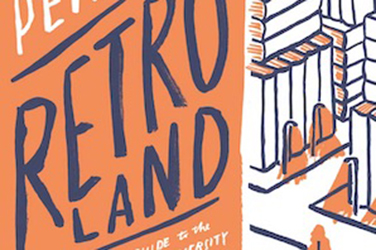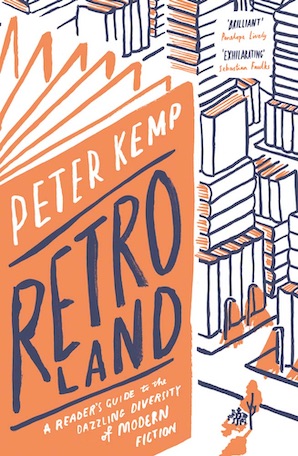
- Free Article: No
- Contents Category: Literary Studies
- Review Article: Yes
- Article Title: Remembrance of forgotten plots
- Article Subtitle: A retro take on fiction
- Online Only: No
- Custom Highlight Text:
In the dying months of the last century, I took a crash course in Modern British Fiction. I had opted for the most contemporary course on the Oxford English MPhil that covered the most contemporary period (1880 to the present, then generally understood to have ended circa 1970). My elective choices had all been a little unpopular: rather than a term parsing Ulysses, I read all of Conrad; where the crowd chose Pound or Eliot for the poetry elective, I turned up at St John’s each week to talk about Yeats.
- Featured Image (400px * 250px):

- Alt Tag (Featured Image): Andrew van der Vlies reviews 'Retroland: A reader’s guide to the dazzling diversity of modern fiction' by Peter Kemp
- Book 1 Title: Retroland
- Book 1 Subtitle: A reader’s guide to the dazzling diversity of modern fiction
- Book 1 Biblio: Yale University Press, US$30 hb, 383 pp
- Book 1 Cover Small (400 x 600):

- Book 1 Cover (800 x 1200):

Kemp’s argument is that this tendency to excavate – or recapitulate – the past constitutes the key marker of writing in English since 1970 (when, he argues, ‘an increasingly extending and intensifying preoccupation with the past got under way’). Not coincidentally, this is when ‘the prefix “retro” first came into vogue’, he points out: writers since ‘have been overwhelmingly drawn into an imaginative territory that constitutes a vast retroland, extensively and inventively concerned with retrospect and recall’. Looking back takes a number of forms, he suggests, using these categories to organise his chapters: ‘engagement with the personal past’, ‘historical fiction’, and work that draws on the literary past. The chief species of retrospection, however, for Kemp is also (in his reading) the reason for all of it: the definitive decline of the British Empire, which precipitated an ‘engrossment with the political past’ such that ‘imperialism and its aftermath widely colonised fiction’. Indeed, Kemp’s book begins with engaging readings of Paul Scott and J.G. Farrell that balance deftly delivered context, illuminating biographical sketches, and thoughtful analysis of key tropes in the work of both writers. But the end of empire does not work so well as explanation for tendencies to retrospection in US fiction, and here it becomes clear that, despite Kemp’s title’s claim to survey ‘modern fiction’, the writing he has in mind is almost entirely produced by British (indeed largely by English) authors. Where it ‘draws on works from North America, the Indian subcontinent, Africa, Australasia and the Far East’, Kemp’s foreword explains, this is generally only ‘whenever, in an age of literary internationalism, they seem relevant to the argument’.
This is very much an argument presented as something more objective, and while I have no especial problem with argument, nor necessarily with Kemp’s that retrospection is a defining mood (a word he might well have used) in English writing, I have two other principal objections: that the range of writing Kemp surveys is not only determinedly English, but often little-Englander; and (second) that it is unclear for whom this volume is intended to serve as a ‘guide’, what species of reader is imagined in his title. Kemp’s is not in the vein of the 1001-books-to-read-before-you-die guides; for all of their banality, those tend not to give the game away, imagining that the moribund reader might survive long enough to enjoy a sampling of the books listed. Kemp, by contrast, is often too devoted to plot summary, and although there is some early indication that he might offer discussion of technique, genre, or narrative perspective, when he pauses summary long enough to point to some quoted prose it is often not clear what he wants us to see. Praising Patrick O’Brian’s ‘appetite for authenticity’, for example, he asks us to appreciate how, ‘as a ship leaves Bombay, it’s noted how “the fetid ooze of the Hooghly gave way to the clearer sea of the Bay of Bengal”’. Not only is this very ordinary prose, it is unfortunate that, in drawing attention to precision, Kemp himself substitutes Bombay for Calcutta.
The colonial nostalgia (and distaste) present here suggests the recurrence of attention to this strand of retrospection. The first chapter’s focus on post-imperial writing does, however, admit the greatest number of non-English authors. Kemp is astute about Salman Rushdie, seeing what makes the work both extraordinary and repetitive. He is withering, however, about those he casts as Rushdie’s imitators, notably Arundhati Roy and Ben Okri. The heroes of this chapter (apart from Farrell and Scott) are writers whose work most closely approximates Kemp’s nineteenth-century touchstones, most especially Dickens. Vikram Seth makes the grade; Zadie Smith (White Teeth features ‘two-dimensional fabrications’) does not. Chimamanda Ngozi Adichie’s Half of a Yellow Sun is okay (capaciousness, ‘attentiveness to voice’), others are passed over quickly before the next exhibit: Timothy Mo (‘exceptional knowledgeability combined with imaginative force, cultural breadth, political acumen, prose crackling with energy and an acutely keen ear for speech’).
Other authors in Kemp’s A-list include Barry Unsworth, Robert Harris, Barnes, Pat Barker, David Mitchell, Sarah Waters, early Hilary Mantel, late Ian McEwan. Several are discussed in successive chapters. Writing about these authors is not infrequently illuminating, but this reader is left wondering at the partiality throughout. One would think Australian literature consisted only of Peter Carey and Thomas Keneally, with no sign of Alexis Wright. There is little room for Irish writing: John Banville is best writing in the style of others, as in Mrs Osmond, his sequel to The Portrait of a Lady; Colm Tóibín has a brief mention, but where, one wonders, are John McGahern, Emma Donoghue, Anna Burns. Scots are thinner on the ground: no James Kelman or (most egregiously) Ali Smith (perhaps J.K. Rowling ticks that box for Kemp). Margaret Atwood stands for all Canada, and US writing is awkwardly handled. Toni Morrison’s Jazz is praised, Beloved barely mentioned, God Help the Child deemed an ‘ill-judged deviation’ from her usual terrain. George Saunders receives exuberant praise, but there is no Don DeLillo, Thomas Pynchon, Colson Whitehead, or Marilynne Robinson. No guide can survey everything, but the index reveals quite how eclectic this particular survey is: twelve titles each for Harris and Mantel, thirteen for McEwan and Barnes. J.M. Coetzee has two entries (the same as Len Deighton). Adichie’s novels, two discussed at some length, are not separately indexed.
Kemp’s guide remains useful – as a survey for those wishing for a reminder of forgotten plots, as a primer for gifting to the relative who enjoys historical fiction, perhaps as a record of a particularly English sense of what fiction might look like. Tellingly, one of the few Barnes novels Kemp does not survey is his excoriating parody of little-England nostalgia, reduced to a commodified simulacrum in the form of a theme park on the Isle of Wight that gives the novel its name (so twee they named it twice). I wonder whether Kemp has read it.


Comments powered by CComment